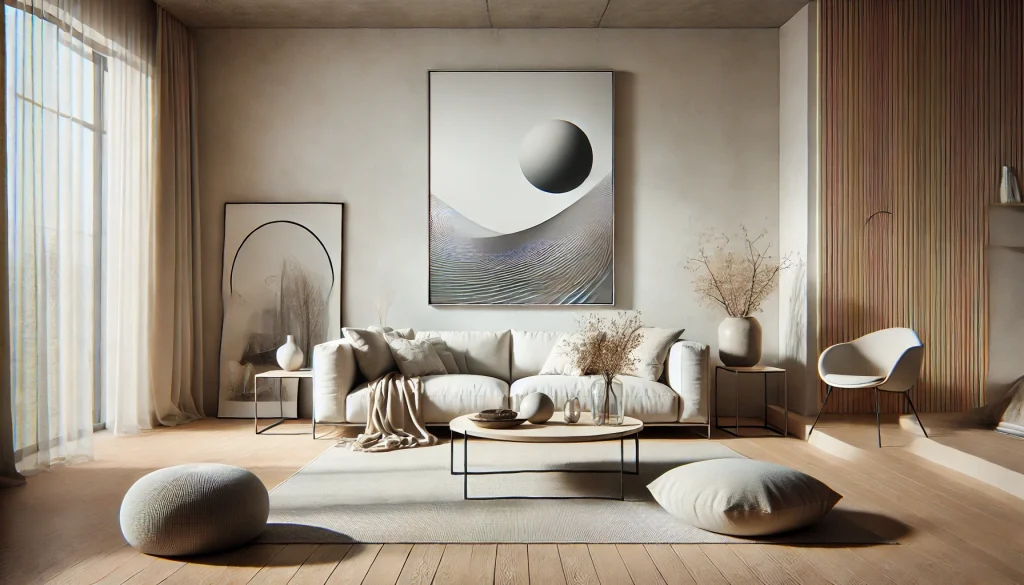The Relationship between Intentional Design and Sustainability in Minimalist Environments

Unveiling the Connection
In an era where environmental concerns dominate discussions, the relationship between intentional design and sustainability becomes increasingly vital. The focus on how our built environments impact ecological health is more prominent than ever. It raises essential questions about our consumption habits, resource usage, and ecological footprints. Minimalist environments, characterized by simplicity and functionality, play a crucial role in promoting sustainable living as they encourage thoughtful interaction with both space and material resources. By concentrating on essential elements, these spaces challenge us to rethink how we interact with our surroundings and serve as a template for a more sustainable lifestyle.
Key Features of Intentional Design
Intentional design emphasizes thoughtfulness in every aspect of a space. This design philosophy extends beyond aesthetics to impact sustainability significantly. Key features include:
- Purposeful use of materials: Selecting sustainable, reclaimed, or natural resources is fundamental to reducing the environmental impact of building and renovating spaces. For instance, using bamboo, which is a fast-growing, renewable resource, can serve as an eco-friendly alternative to traditional hardwood.
- Efficient layouts: Creating functional spaces that utilize less energy begins with smart designs. For example, open floor plans allow for better airflow and natural light, reducing the need for artificial heating and cooling systems that consume vast amounts of energy.
- Timeless aesthetics: Prioritizing durability and longevity over fleeting trends means investing in quality items that stand the test of time. Furniture made from high-quality, sustainable materials that do not go out of style can reduce the frequency of replacements and, consequently, waste.
The Role of Minimalism in Sustainability
Minimalism inherently fosters sustainable practices through its core principles. The approach helps individuals and communities:
- Reduce waste: The philosophy of owning fewer items directly leads to less consumption and waste. With the rise of minimalistic lifestyle movements, many are finding fulfillment in decluttering their lives and only keeping what brings them joy.
- Enhance energy efficiency: Simple spaces often require less energy. For example, homes designed with minimal furnishings can maximize energy efficiency by reducing the volume that needs to be heated or cooled.
- Promote mindfulness: Adopting a minimalist mindset encourages conscious choices in daily living. This mindfulness can extend to how we shop, eat, and interact with our environments, leading to a more sustainable way of life.
As we dig deeper into this topic, we will explore how these principles intertwine to create not just aesthetically pleasing, but also environmentally responsible, living spaces. The fusion of intentional design with minimalistic ideals heralds a shift towards a future where ecology and elegance coexist. This relationship opens up conversations about the responsibility we have to our planet and the well-being of future generations, urging us to reconsider the spaces we inhabit and the choices we make within them.
DISCOVER MORE: Click here to learn how minimalism can help you achieve your time goals

Designing with Purpose for a Sustainable Future
The fusion of intentional design and sustainability in minimalist environments is not merely a concept but a necessary approach to addressing pressing environmental issues. This relationship stems from the idea that every design decision can have profound implications for both the user and the planet. One key aspect lies in acknowledging the impact of our choices, especially in regions like the United States, where resource consumption is particularly high. Implementing intentional practices in design can significantly reduce environmental strain and enhance the livability of spaces.
Integrating Functionality and Aesthetics
In intentional design, the interplay between functionality and aesthetics is critical. Minimalist environments prioritize essential elements that enhance both user experience and environmental health. Some of the factors that contribute to this integration include:
- Natural lighting: The strategic placement of windows and open spaces maximizes natural light, which reduces the need for electric lighting during the day. This not only conserves energy but also creates a soothing atmosphere that enhances well-being.
- Multifunctional spaces: Designing spaces that serve multiple purposes helps to optimize area usage. For example, a living room that doubles as a workspace reduces the need for additional rooms, thus consuming fewer resources and reducing the overall footprint of a home.
- Smart technology: Incorporating energy-efficient appliances into minimalist designs can significantly lower energy consumption. Smart home systems allow residents to monitor and control energy usage, enabling more efficient resource management.
This emphasis on functionality ensures a focused approach to design that not only meets user needs but also aligns with broader sustainability objectives. By designing spaces that require fewer resources, homeowners can enjoy a reduced carbon footprint and leave a lasting impact on their communities.
The Psychological Benefits of Minimalism
Beyond the physical and environmental advantages, embracing a minimalist mindset can foster psychological well-being. Research has shown that decluttering and simplifying one’s environment can lead to decreased stress and heightened focus. This mental clarity can encourage individuals to make more sustainable choices. The psychological benefits of minimalism can manifest in various ways:
- Increased mindfulness: As individuals adopt a minimalist lifestyle, they become more conscious of their consumption habits, which can lead to more deliberate purchasing decisions and promote sustainable living practices.
- Enhanced creativity: A clean and simple environment encourages creativity by allowing individuals to think more freely without distractions, paving the way for innovative solutions to environmental challenges.
- Greater appreciation for nature: Minimalism often emphasizes a connection with the natural world, encouraging individuals to seek out outdoor experiences and inspire an advocacy for environmental preservation.
In summary, the relationship between intentional design and sustainability within minimalist environments is a dynamic interplay that offers a pathway to a more eco-friendly and fulfilling lifestyle. By embracing intentionality in design and the simplicity of minimalism, individuals can cultivate spaces that not only reflect their values but also contribute positively to the health of the planet.
The Relationship between Intentional Design and Sustainability in Minimalist Environments
As we delve deeper into the compelling intersection of intentional design and sustainability, it becomes clear that minimalist environments are more than just aesthetics; they are embodiments of lifestyle choices that prioritize the Earth’s resources. Minimalism, often characterized by simplicity and functionality, encourages a profound relationship with our surroundings and can substantially reduce our ecological footprint.
When applying intentional design principles, every element in a minimalist space is carefully curated, focusing on quality over quantity. This selective approach fosters the use of sustainable materials, promoting a culture of mindful consumption. Innovative designs, such as multi-functional furniture, further contribute to resourcefulness, allowing individuals to maximize their living spaces while minimizing waste. This emphasis on purposeful living is a direct representation of how intentional design aligns with sustainability efforts.
Another crucial aspect is the emphasis on natural light and ventilation in minimalist architecture. These design features not only enhance the aesthetic experience but also significantly reduce energy consumption, leading to a healthier and more sustainable living environment. As communities become increasingly aware of the need for sustainability, professionals in architecture and design are embracing philosophies that intertwine functionality with environmental responsibility.
| Advantages | Explanations |
|---|---|
| Resource Efficiency | Minimized consumption leads to less waste, allowing for sustainable living. |
| Enhanced Well-being | Intentionally designed spaces reduce stress and improve mood, connecting individuals with nature. |
The significance of these elements cannot be overstated, as they resonate deeply with a growing public consciousness regarding environmental issues. The trend toward embracing intentional design in minimalist environments serves as a beacon for encouraging sustainable habits and practices that contribute to the well-being of our planet. Each step taken in this direction, whether through material choices or spatial configurations, influences a broader narrative around sustainability and design.
DIVE DEEPER: Click here to discover transformative tips
Creating Resilient Communities through Intentional Design
As society grapples with the effects of climate change and unsustainable resource consumption, the principles of intentional design in minimalist environments offer innovative solutions to these challenges. By embracing minimalism, communities can foster resilience that extends beyond individual households to create broader societal impacts. Central to this vision is the idea that sustainable design can empower communities by promoting resource-sharing and collaboration.
Community Engagement and Shared Resources
One significant advantage of minimalist design is its ability to facilitate community interaction and cooperation. Projects that prioritize shared spaces—such as community gardens, outdoor gathering areas, and co-working spaces—are examples of how intentional design can encourage collective action. These shared resources not only reduce the need for individual material consumption but also nurture social connections among residents. Key elements of this community-centric approach include:
- Co-housing initiatives: These projects group home designs into clusters that promote interaction while providing shared amenities, such as laundry facilities and communal kitchens, ultimately lowering resource use to benefit both the environment and the community.
- Vertical gardens: Utilize urban spaces by transforming rooftops and walls into green sanctuaries, improving air quality and sustaining biodiversity while actively engaging community members in gardening practices.
- Resource libraries: Establishing tool and equipment libraries allows residents to borrow seldom-used items, such as power tools and camping gear, which minimizes waste and reduces the overall consumption of goods.
By implementing these strategies, communities can create environments where sustainability thrives alongside camaraderie and shared responsibility, illustrating how intentional design fosters a collective commitment to creating a better future.
Material Choices for Minimalist Environments
The selection of materials in design plays a pivotal role in aligning intentionality with sustainability. Minimalist environments often prioritize durable, recycled, and locally-sourced materials that minimize environmental impact. Key considerations in material selection include:
- Biodegradable materials: Opting for materials that can naturally decompose at the end of their life cycle reduces landfill waste and allows designers to close the loop on product life cycles.
- Sustainable wood products: Utilizing reclaimed or certified sustainably sourced wood ensures that deforestation is mitigated and promotes responsible forestry practices.
- Low-VOC finishes: Incorporating paints and finishes with low volatile organic compounds improves indoor air quality while also contributing to healthier environments for occupants.
Through careful material selection, designers can demonstrate that intentional design is inextricably linked to sustainability, ultimately revolutionizing the impact of our living spaces. This alignment encourages individuals to embrace an approach where the choice of materials reflects a commitment to ethical consumption and environmental stewardship.
Adaptive Reuse and Repurposing
Complementing the principles of minimalist design is the growing trend of adaptive reuse, which breathes new life into old spaces. This practice involves repurposing existing buildings for new functions, thus reducing the need for new construction and minimizing waste. Notable examples within the United States include:
- Warehouse conversions: Transforming long-abandoned factories into vibrant residential lofts or commercial spaces creates modern environments while preserving the historical fabric of neighborhoods.
- Historic preservation: Revitalizing historic buildings as community centers or mixed-use facilities ensures that cultural identity is maintained while optimizing resource use.
- Deconstruction: Unlike traditional demolition, deconstruction focuses on dismantling structures to salvage valuable materials, preventing waste and encouraging sustainable practices in construction.
This trend not only showcases the beauty in existing architecture but also promotes a culture of sustainability that emphasizes the importance of rethinking how we utilize resources. As intentional design leads to adaptive reuse, communities move toward solutions that harmonize modern needs with ecological mindfulness.
DISCOVER: Click here to unlock transformative daily habits
Conclusion: Redefining Our Future Through Intentional Design
The intricate relationship between intentional design and sustainability in minimalist environments is not merely a theory, but a tangible approach to reinterpreting the way we inhabit spaces. By fostering a philosophy that values simplicity and purpose, communities can promote a sustainable lifestyle that prioritizes environmental integrity while enhancing social connections and resilience.
As we explore avenues such as adaptive reuse, sustainable material choices, and community-centric initiatives, we see a profound shift in how urban and rural environments can be crafted to meet modern challenges. The success of such designs lies in their ability to not only serve individual needs but also cultivate shared resources and collective responsibility. This approach empowers communities to thrive together, deriving strength from unity in action.
Moreover, the integration of minimalist practices into our architecture and urban planning reflects a broader cultural shift towards sustainability. The conscious selection of materials, paired with innovative practices such as co-housing and vertical gardening, exemplifies how a reimagined environment can support a lower ecological footprint without sacrificing quality of life.
In the face of urgent global challenges such as climate change and dwindling natural resources, the principles of intentional design in minimalist environments offer a roadmap for a resilient future. It invites us all to rethink our relationships with our surroundings and encourages a collective movement towards sustainability. As we embrace these principles, we not only enhance our living spaces but also contribute to a more conscientious and sustainable world for generations to come.


